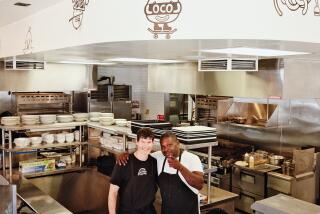New Mural Wraps Watts Church in Its Colorful History
This Catholic church in the middle of Watts has stood strong through times of civil revolt and decades of demographic tumult.
It survived unscathed when most everything around it burned during the riots of 1965 and then 1992. It has undergone profound demographic shifts: nearly all white through the 1920s, nearly all black in 1950s and ‘60s. Mostly Latino in 2000.
The people of St. Lawrence of Brindisi have long represented the faces, struggles and celebrations of the people of Los Angeles.
On Sunday, their story was told on the 150-foot-long wall around the church parking lot during the dedication of a sweeping mural that chronicles their lives and honors their diversity.
“The mural is a sign of hope to our community,” said the pastor, Father Peter Banks, who commissioned the giant painting. “It is a reminder of our past, and it is the hope that as we bring many groups in this church, we can come together in our diversity.”
Artists painted the finishing touches on the mural during the big parking lot party Sunday afternoon. They had painted a few saints, including St. Francis of Assisi, founder of the Franciscan order of priests, and St. Martin de Porres, who suffered discrimination because of his mixed race, Banks said.
There is the painted likeness of a modern-day martyr: Archbishop Oscar Romero of El Salvador, gunned down while celebrating Mass in 1980. American civil rights leaders Martin Luther King Jr. and Cesar Chavez have their place on the wall.
Then there is the smiling face of Mary Dudley, 76, who has been a member of the congregation for 70 years.
But it is the Virgin of Guadalupe, the patron saint of Mexico, whose image towers over all on the mural, to the delight of the congregation. Today, the 90-year-old stucco church boasts 3,000 members, 30% African American and 70% Latino.
Balancing the needs of the two groups has at times been a struggle, but has provided rewards in building understanding between cultures, Banks said.
Two years ago, after returning to the church where he started as a novice right out of seminary, Banks dreamed up the mural as a way to remind the church’s two ethnic populations, as well as the entire community, that they can come together to worship and celebrate.
Latino parishioners made tacos and corn on the cob, while a few feet away, black parishioners served Southern barbecue.
“For me, it means a lot of respect for the Catholic religion,” said Helda Mena, 20, who was showing her 2-year-old son the centerpiece painting of the Virgin.
“The mural is a visual reminder for us all to come together,” said Doris Wilson, 64. “After all, we’re not Irish, but we all celebrate St. Patrick’s Day.”
“Darn right you do,” said Banks in his heavy Irish brogue.
The Franciscan priest, wearing long brown robes tied at the waist with rope, is part of the church’s diverse face. He first came to St. Lawrence from Ireland in 1972 and is known for his warm and welcoming demeanor and loud, raucous laugh.
Back then, the congregation was almost all black, but some Spanish-speaking worshipers, part of a wave of Latino immigrants, had begun coming to the all-English services. In 1979, Banks began a Spanish Mass, which attracted about 50 people. Today, the church has four Spanish Masses.
“It’s more difficult to live in a bilingual parish,” Banks said, noting that Latino parishioners are used to spending a lot of time at the church and are more comfortable asking for help in solving a variety of problems. That has sometimes left black parishioners feeling excluded and ignored, Banks said.
“But we’re making it work,” he said, greeting one worshiper in Spanish and switching to English to talk to another. “We have a long way to go, but we’re trying to do it.”
The mural is one way of showing church members that they are all valued, no matter who they are. Along with Dudley, the mural includes several other beloved locals, including Nancy Santa Rosa, a first-grader suffering from cancer, and Ethel Leitermann, the last white member of the parish, who moved to Boise, Idaho, 10 years ago.
There is 10-year-old Anai Velazquez, who is part of the church’s children’s choir. “My parents are so proud,” Anai said. “And the mural teaches us to remember important stuff, like the Virgin of Guadalupe.”
And as a special tribute, a picture of Banks’ mother has a place on the wall.
Mary Dudley, who found a shady place to observe the festivities Sunday, said that when her family came to the church in 1930 after moving from New Orleans, hers was one of the few black families in a sea of white faces. Over the years, she has watched the membership change.
“But this church has always felt like home,” she said.
More to Read
Sign up for Essential California
The most important California stories and recommendations in your inbox every morning.
You may occasionally receive promotional content from the Los Angeles Times.










